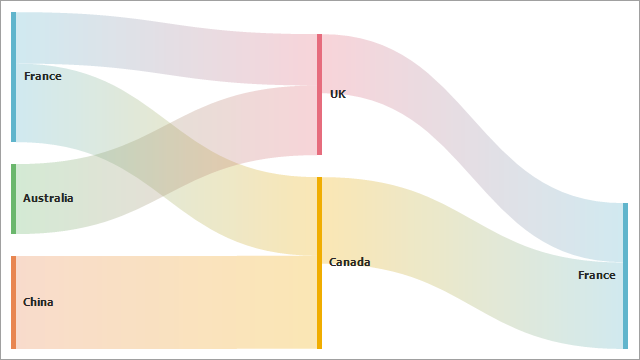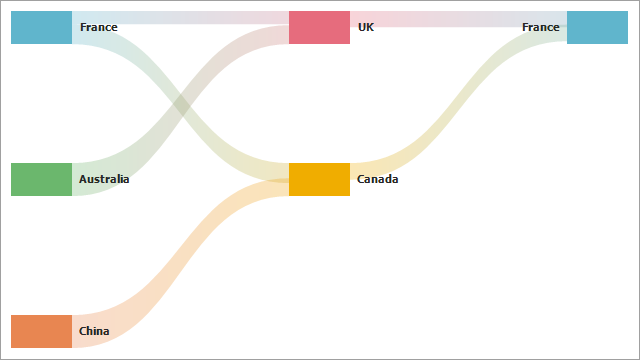SankeyDiagramControl.LayoutAlgorithm Property
Specifies Sankey layout algorithm settings.
Namespace: DevExpress.XtraCharts.Sankey
Assembly: DevExpress.XtraCharts.v21.1.UI.dll
NuGet Packages: DevExpress.Win.Charts, DevExpress.Win.Design
Declaration
Property Value
| Type | Description |
|---|---|
| SankeyLayoutAlgorithmBase | Contains Sankey layout algorithm settings. |
Remarks
Linear Layout Algorithm
You can use the predefined linear layout algorithm. Cast the LayoutAlgorithm property value to SankeyLinearLayoutAlgorithm to change default settings. Use the SankeyLinearLayoutAlgorithm.NodeAlignment property to specify the node alignment.
The following example aligns nodes to the bottom of the SankeyDiagramControl:

SankeyLinearLayoutAlgorithm layoutAlgorithm = (SankeyLinearLayoutAlgorithm)sankey.LayoutAlgorithm;
layoutAlgorithm.NodeAlignment = SankeyNodeAlignment.Near;
Custom Layout Algorithm
To implement a custom layout, create a descendant of the SankeyLayoutAlgorithmBase class. Override the SankeyLayoutAlgorithmBase.CalculateNodeBounds method to specify node bounds:

private void Form1_Load(object sender, EventArgs e) {
SankeyDiagramControl sankeyDiagramControl1 = new SankeyDiagramControl();
this.Controls.Add(sankeyDiagramControl1);
List<SankeyItem> data = new List<SankeyItem> {
new SankeyItem { Source = "France", Target = "UK", Value = 53 },
new SankeyItem { Source = "Australia", Target = "UK", Value = 72 },
new SankeyItem { Source = "France", Target = "Canada", Value = 81 },
new SankeyItem { Source = "China", Target = "Canada", Value = 96 },
new SankeyItem { Source = "UK", Target = "France", Value = 61 },
new SankeyItem { Source = "Canada", Target = "France", Value = 89 }
};
sankeyDiagramControl1.DataSource = data;
sankeyDiagramControl1.SourceDataMember = "Source";
sankeyDiagramControl1.TargetDataMember = "Target";
sankeyDiagramControl1.WeightDataMember = "Value";
sankeyDiagramControl1.LayoutAlgorithm = new MyLayoutAlgorithm();
sankeyDiagramControl1.Width = 640;
sankeyDiagramControl1.Height = 360;
}
public class SankeyItem {
public string Source { get; set; }
public string Target { get; set; }
public double Value { get; set; }
}
public class MyLayoutAlgorithm : SankeyLayoutAlgorithmBase {
void SpreadLevelIndex(ISankeyNodeLayoutItem node, int startingLevelIndex = 0) {
node.LevelIndex = startingLevelIndex;
if (node.OutputLinks == null)
return;
foreach (var outputLink in node.OutputLinks)
SpreadLevelIndex(outputLink.Target, startingLevelIndex + 1);
}
public override void CalculateNodeBounds(IEnumerable<ISankeyNodeLayoutItem> nodes, Rectangle bounds) {
foreach (var node in nodes)
if (node.InputLinks == null || node.InputLinks.Count == 0)
SpreadLevelIndex(node);
int nodeWidth = bounds.Width / 10;
int nodeHeight = bounds.Height / 10;
int levelCount = nodes.Max(node => node.LevelIndex) + 1;
int spaceBetweenLevels = (bounds.Width - nodeWidth) / (levelCount - 1);
int maxNodeCountInALevel = nodes.GroupBy(node => node.LevelIndex).Max(group => group.Count());
int spaceBetweenNodes = (bounds.Height - nodeHeight) / (maxNodeCountInALevel - 1);
Dictionary<int, int> levelNodeCountPairs = new Dictionary<int, int>();
foreach (var node in nodes) {
if (!levelNodeCountPairs.TryGetValue(node.LevelIndex, out int nodeCount))
levelNodeCountPairs.Add(node.LevelIndex, 0);
levelNodeCountPairs[node.LevelIndex]++;
node.Bounds = new Rectangle(bounds.Left + node.LevelIndex * spaceBetweenLevels, bounds.Top + nodeCount * spaceBetweenNodes, nodeWidth, nodeHeight);
}
}
}